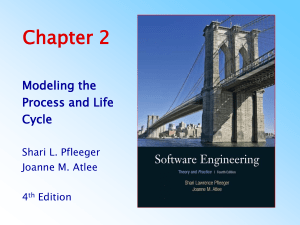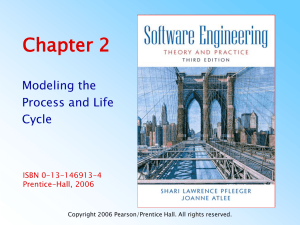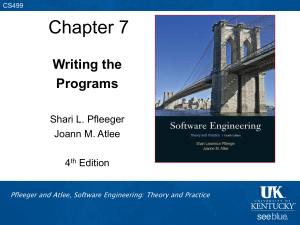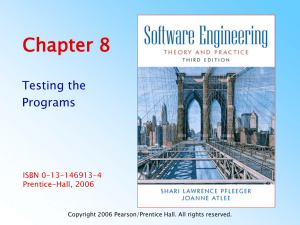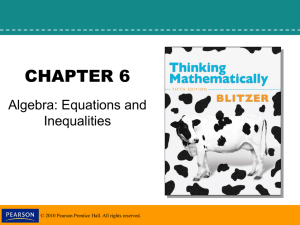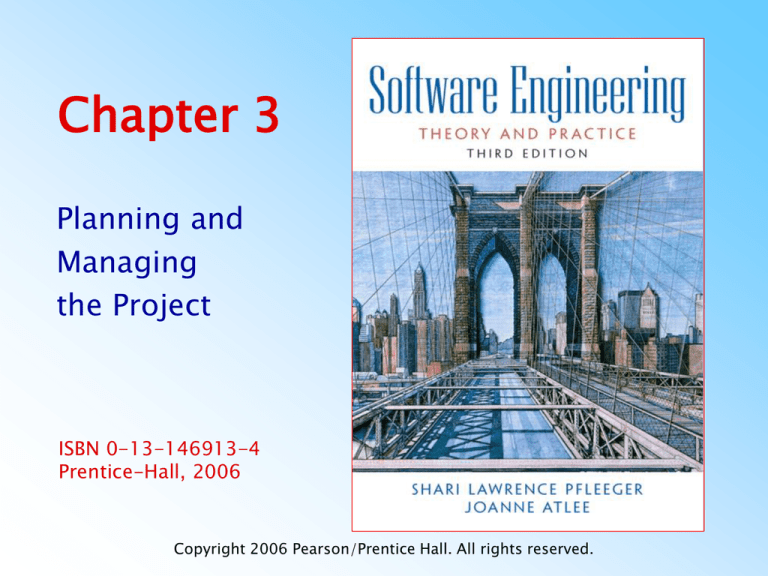
Chapter 3
Planning and
Managing
the Project
ISBN 0-13-146913-4
Prentice-Hall, 2006
Copyright 2006 Pearson/Prentice Hall. All rights reserved.
Contents
3.1
3.2
3.3
3.4
3.5
3.6
3.7
3.8
3.9
Tracking Progress
Project Personnel
Effort Estimation
Risk Management
The Project Plan
Process Models and Project Management
Information System Example
Real Time Example
What this Chapter Means for You
Pfleeger and Atlee, Software Engineering: Theory and Practice
© 2006 Pearson/Prentice Hall
Page 3.2
Chapter 3 Objectives
• Tracking project progress
• Project personnel and organization
• Effort and schedule estimation
• Risk management
• Using process modeling with project
planning
Pfleeger and Atlee, Software Engineering: Theory and Practice
© 2006 Pearson/Prentice Hall
Page 3.3
3.1 Tracking Progress
• Do you understand customer’s problems and
needs?
• Can you design a system to solve customer’s
problems or satisfy customer’s needs?
• How long will it take you to develop the
system?
• How much will it cost to develop the system?
Pfleeger and Atlee, Software Engineering: Theory and Practice
© 2006 Pearson/Prentice Hall
Page 3.4
3.1 Tracking Progress
Project Schedule
• Describes the software-development cycle
for a particular project by
– enumerating the phases or stages of the project
– breaking each phase into discrete tasks or
activities to be completed
• Portrays the interactions among the activities
and estimates the times that each task or
activity will take
Pfleeger and Atlee, Software Engineering: Theory and Practice
© 2006 Pearson/Prentice Hall
Page 3.5
3.1 Tracking Progress
Project Schedule: Approach
• Understanding customer’s needs by listing
all project deliverables
–
–
–
–
–
Documents
Demonstrations
Demonstrations
Demonstrations
Demonstrations
security
of
of
of
of
function
subsystems
accuracy
reliability, performance or
• Determining milestones and activities to
produce the deliverables
Pfleeger and Atlee, Software Engineering: Theory and Practice
© 2006 Pearson/Prentice Hall
Page 3.6
3.1 Tracking Progress
Milestones and activities
• Activity: takes place over a period of time
• Milestone: completion of an activity -- a
particular point in time
• Precursor: event or set of events that must
occur in order for an activity to start
• Duration: length of time needed to complete
an activity
• Due date: date by which an activity must be
completed
Pfleeger and Atlee, Software Engineering: Theory and Practice
© 2006 Pearson/Prentice Hall
Page 3.7
3.1 Tracking Progress
Project Schedule (continued)
• Project development can be separated into a
succession of phases which are composed of
steps, which are composed of activities
Pfleeger and Atlee, Software Engineering: Theory and Practice
© 2006 Pearson/Prentice Hall
Page 3.8
3.1 Tracking Progress
Project Schedule (continued)
• Table 3.1 shows the phases, steps and
activities to build a house
– landscaping phase
– building the house phase
• Table 3.2 lists milestones for building the
house phase
Pfleeger and Atlee, Software Engineering: Theory and Practice
© 2006 Pearson/Prentice Hall
Page 3.9
3.1 Tracking Progress
Phases, Steps, and Activities in Building a House
Phase 1: Landscaping the lot
Step 1.1:
Clearing
and
grubbing
Activity 1.1.1: Remove trees
Activity 1.1.2: Remove stumps
Step 1.2:
Seeding
the turf
Activity 1.2.1: Aerate the soil
Activity 1.2.2: Disperse the seeds
Activity 1.2.3: Water and weed
Step 1.3:
Planting
shrubs and
trees
Activity 1.3.1: Obtain shrubs and
trees
Activity 1.3.2: Dig holes
Activity 1.3.3: Plant shrubs and trees
Activity 1.3.4: Anchor the trees and
mulch around them
Phase 2: Building the house
Step 2.1:
Prepare
the site
Activity 2.1.1: Survey the land
Activity 2.1.2: Request permits
Activity 2.1.3: Excavate for the
foundation
Activity 2.1.4: Buy materials
Step 2.2:
Building
the
exterior
Activity 2.2.1: Lay the foundation
Activity 2.2.2: Build the outside walls
Activity 2.2.3:
plumbing
Activity 2.2.4:
work
Activity 2.2.5:
Activity 2.2.6:
Install exterior
Exterior electrical
Exterior siding
Paint the exterior
Activity 2.2.7: Install doors and
fixtures
Activity 2.2.8: Install roof
Step 2.3:
Finishing
the interior
Activity 2.3.1: Install the interior
plumbing
Activity 2.3.2: Install interior
electrical work
Activity 2.3.3: Install wallboard
Activity 2.3.4: Paint the interior
Activity 2.3.5: Install floor covering
Activity 2.3.6: Install doors and
fixtures
Pfleeger and Atlee, Software Engineering: Theory and Practice
© 2006 Pearson/Prentice Hall
Page 3.10
3.1 Tracking Progress
Milestones in Building a House
1.1.
1.2.
1.3.
1.4.
2.1.
2.2.
2.3.
2.4.
2.5.
2.6.
2.7.
2.8.
3.1.
3.2.
3.3.
3.4.
3.5.
3.6.
Survey complete
Permits issued
Excavation complete
Materials on hand
Foundation laid
Outside walls complete
Exterior plumbing complete
Exterior electrical work complete
Exterior siding complete
Exterior painting complete
Doors and fixtures mounted
Roof complete
Interior plumbing complete
Interior electrical work complete
Wallboard in place
Interior painting complete
Floor covering laid
Doors and fixtures mounted
Pfleeger and Atlee, Software Engineering: Theory and Practice
© 2006 Pearson/Prentice Hall
Page 3.11
3.1 Tracking Progress
Work Breakdown and Activity Graphs
• Work breakdown structure depicts the
project as a set of discrete pieces of work
• Activity graphs depict the dependencies
among activities
– Nodes: project milestones
– Lines: activities involved
Pfleeger and Atlee, Software Engineering: Theory and Practice
© 2006 Pearson/Prentice Hall
Page 3.12
3.1 Tracking Progress
Work Breakdown and Activity Graphs (continued)
• Activity graph for building a house
Pfleeger and Atlee, Software Engineering: Theory and Practice
© 2006 Pearson/Prentice Hall
Page 3.13
3.1 Tracking Progress
Estimating Completion
• Adding estimated time in activity graph of each
activity to be completed tells us more about the
project's schedule
Pfleeger and Atlee, Software Engineering: Theory and Practice
© 2006 Pearson/Prentice Hall
Page 3.14
3.1 Tracking Progress
Estimating Completion for Building a House
Activity
Step 1: Prepare the site
Activity 1.1: Survey the land
Activity 1.2: Request permits
Activity 1.3: Excavate for the foundation
Activity 1.4: Buy materials
Step 2: Building the exterior
Activity 2.1: Lay the foundation
Activity 2.2: Build the outside walls
Activity 2.3: Install exterior plumbing
Activity 2.4: Exterior electrical work
Activity 2.5: Exterior siding
Activity 2.6: Paint the exterior
Activity 2.7: Install doors and fixtures
Activity 2.8: Install roof
Step 3: Finishing the interior
Activity 3.1: Install the interior plumbing
Activity 3.2: Install interior electrical work
Activity 3.3: Install wallboard
Activity 3.4: Paint the interior
Activity 3.5: Install floor covering
Activity 3.6: Install doors and fixtures
Time estimate (in days)
Pfleeger and Atlee, Software Engineering: Theory and Practice
© 2006 Pearson/Prentice Hall
3
15
10
10
15
20
10
10
8
5
6
9
12
15
9
18
11
7
Page 3.15
3.1 Tracking Progress
Critical Path Method (CPM)
• Minimum amount of time it will take to
complete a project
– Reveals those activities that are most critical to
completing the project on time
• Real time (actual time): estimated amount of
time required for the activity to be completed
• Available time: amount of time available in the
schedule for the activity's completion
• Slack time: the difference between the
available time and the real time for that
activity
Pfleeger and Atlee, Software Engineering: Theory and Practice
© 2006 Pearson/Prentice Hall
Page 3.16
3.1 Tracking Progress
Critical Path Method (CPM) (continued)
• Critical path: the slack at every node is zero
– can be more than one in a project schedule
• Slack time = available time – real time
= latest start time – earliest start time
Pfleeger and Atlee, Software Engineering: Theory and Practice
© 2006 Pearson/Prentice Hall
Page 3.17
Slack Time for Activities of Building a
House
Activity
1.1
1.2
1.3
1.4
2.1
2.2
2.3
2.4
2.5
2.6
2.7
2.8
3.1
3.2
3.3
3.4
3.5
3.6
Finish
Earliest start
time
1
1
16
26
36
51
71
81
91
99
104
104
71
83
98
107
107
118
124
Latest start
time
13
1
16
26
36
51
83
93
103
111
119
116
71
83
98
107
107
118
124
Pfleeger and Atlee, Software Engineering: Theory and Practice
© 2006 Pearson/Prentice Hall
Slack
12
0
0
0
0
0
12
12
12
12
15
12
0
0
0
0
0
0
0
Page 3.18
3.1 Tracking Progress
CPM Bar Chart
• Including information about the early and late
start dates
• Asterisks indicate the critical path
Pfleeger and Atlee, Software Engineering: Theory and Practice
© 2006 Pearson/Prentice Hall
Page 3.19
3.1 Tracking Progress
Tools to Track Progress
• Example: to track progress of building a
communication software
Pfleeger and Atlee, Software Engineering: Theory and Practice
© 2006 Pearson/Prentice Hall
Page 3.20
3.1 Tracking Progress
Tools to Track Progress: Gantt Chart
• Activities shown in parallel
– helps understand which activities can be
performed concurrently
Pfleeger and Atlee, Software Engineering: Theory and Practice
© 2006 Pearson/Prentice Hall
Page 3.21
3.1 Tracking Progress
Tools to Track Progress: Resource Histogram
• Shows people assigned to the project and
those needed for each stage of development
Pfleeger and Atlee, Software Engineering: Theory and Practice
© 2006 Pearson/Prentice Hall
Page 3.22
3.1 Tracking Progress
Tools to Track Progress: Expenditures Tracking
• An example of how expenditures can be
monitored
Pfleeger and Atlee, Software Engineering: Theory and Practice
© 2006 Pearson/Prentice Hall
Page 3.23
3.2 Project Personnel
• Key activities requiring personnel
–
–
–
–
–
–
–
–
requirements analysis
system design
program design
program implementation
testing
training
maintenance
quality assurance
• There is great advantage in assigning
different responsibilities to different people
Pfleeger and Atlee, Software Engineering: Theory and Practice
© 2006 Pearson/Prentice Hall
Page 3.24
3.2 Project Personnel
Choosing Personnel
• Ability to perform work
• Interest in work
• Experience with
– similar applications
– similar tools, languages, or techniques
– similar development environments
•
•
•
•
Training
Ability to communicate with others
Ability to share responsibility
Management skills
Pfleeger and Atlee, Software Engineering: Theory and Practice
© 2006 Pearson/Prentice Hall
Page 3.25
3.2 Project Personnel
Communication
• A project's progress is affected by
– degree of communication
– ability of individuals to communicate their ideas
• Software failures can result from breakdown
in communication and understanding
Pfleeger and Atlee, Software Engineering: Theory and Practice
© 2006 Pearson/Prentice Hall
Page 3.26
3.2 Project Personnel
Communication (continued)
• Line of communication can grow quickly
• If there is n worker in project, then there are
n(n-1)/2 pairs of communication
Pfleeger and Atlee, Software Engineering: Theory and Practice
© 2006 Pearson/Prentice Hall
Page 3.27
3.2 Project Personnel
Sidebar 3.1 Make Meeting Enhance Project Progress
• Common complaints about meetings
–
–
–
–
–
–
the purpose is unclear
the attendees are unprepared
essential people are late or absent
the conversation veers away from its purpose
participants do not discuss, instead argue
decisions are never enacted afterward
• Ways to ensure a productive meeting
–
–
–
–
clearly decide who should be in the meeting
develop an agenda
have someone who tracks the discussion
have someone who ensures follow-up actions
Pfleeger and Atlee, Software Engineering: Theory and Practice
© 2006 Pearson/Prentice Hall
Page 3.28
3.2 Project Personnel
Work Styles
• Extroverts: tell their thoughts
• Introverts: ask for suggestions
• Intuitives: base decisions on feelings
• Rationals: base decisions on facts, options
Pfleeger and Atlee, Software Engineering: Theory and Practice
© 2006 Pearson/Prentice Hall
Page 3.29
3.2 Project Personnel
Work Styles (continued)
• Horizontal axis: communication styles
• Vertical axis: decision styles
Pfleeger and Atlee, Software Engineering: Theory and Practice
© 2006 Pearson/Prentice Hall
Page 3.30
3.2 Project Personnel
Work Styles (continued)
• Work styles determine communication styles
• Understanding workstyles
– Helps you to be flexible
– give information about other's priorities
• Affect interaction among customers,
developers and users
Pfleeger and Atlee, Software Engineering: Theory and Practice
© 2006 Pearson/Prentice Hall
Page 3.31
3.2 Project Personnel
Project Organization
• Depends on
– backgrounds and work styles of team members
– number of people on team
– management styles of customers and developers
• Examples:
– Chief programmer team: one person totally
responsible for a system's design and
development
– Egoless approach: hold everyone equally
responsible
Pfleeger and Atlee, Software Engineering: Theory and Practice
© 2006 Pearson/Prentice Hall
Page 3.32
3.2 Project Personnel
Project Organization: Chief Programmer Team
• Each team member must communicate often
with chief, but not necessarily with other
team members
Pfleeger and Atlee, Software Engineering: Theory and Practice
© 2006 Pearson/Prentice Hall
Page 3.33
3.2 Project Personnel
Project Organization (continued)
• Characteristics of projects and the suggested
organizational structure to address them
Highly structured
High certainty
Repetition
Large projects
Loosely structured
Uncertainty
New techniques or technology
Small projects
Pfleeger and Atlee, Software Engineering: Theory and Practice
© 2006 Pearson/Prentice Hall
Page 3.34
3.2 Project Personnel
Sidebar 3.2 Structure vs. Creativity
• Experiment by Sally Phillip examining two
groups building a hotel
– structured team: clearly defined responsibilities
– unstructured team: no direction, incredibly
creative
• The results are always the same
• Good project management means finding a
balance between structure and creativity
Pfleeger and Atlee, Software Engineering: Theory and Practice
© 2006 Pearson/Prentice Hall
Page 3.35
3.3 Effort Estimation
• Estimating project costs is one of the crucial
aspects of project planning and management
• Estimating cost has to be done as early as
possible during the project life cycle
• Type of costs
– facilities: hardware space, furniture, telephone,
etc
– methods and tools: software, tools for designing
software (Computer-Aiede Software Engineering
or CASE)
– staff (effort): the biggest component of cost
Pfleeger and Atlee, Software Engineering: Theory and Practice
© 2006 Pearson/Prentice Hall
Page 3.36
3.3 Effort Estimation
Estimation Should be Done Repeatedly
• Uncertainty early in the project can affect the
accuracy of cost and size estimations
Pfleeger and Atlee, Software Engineering: Theory and Practice
© 2006 Pearson/Prentice Hall
Page 3.37
3.3 Effort Estimation
Sidebar 3.3 Causes of Inaccurate Estimates
• Key causes
–
–
–
–
–
Frequent request for change by users
Overlooked tasks
User's lack of understanding of the requirements
Insufficient analysis when developing estimate
Lack of coordination of system development,
technical services, operations, data
administration, and other functions during
development
– Lack of an adequate method or guidelines for
estimating
Pfleeger and Atlee, Software Engineering: Theory and Practice
© 2006 Pearson/Prentice Hall
Page 3.38
3.3 Effort Estimation
Sidebar 3.3 Causes of Inaccurate Estimates (continued)
• Key influences
–
–
–
–
–
–
–
–
–
–
Complexity of the proposed application system
Required integration with existing system
Complexity of the program in the system
Size of the system expressed as number of functions or
programs
Capabilities of the project team members
Project team's experience with the application, the
programming language, and hardware
Capabilities of the project team members
Database management system
Number of project team member
Extent of programming and documentation standards
Pfleeger and Atlee, Software Engineering: Theory and Practice
© 2006 Pearson/Prentice Hall
Page 3.39
3.3 Effort Estimation
Type of Estimation Methods
• Expert judgment
• Top-down or bottom-up
– Analogy: pessimistic (x), optimistic (y), most likely
(z); estimate as (x + 4y + z)/6
– Delphi technique: based on the average of “secret”
expert judgments
– Wolverton model: old (mid 70’s)
• Algorithmic methods: E = (a + bSc) m(X)
– Walston and Felix model: E = 5.25S
0.91
– Bailey and Basili model: E = 5.5 + 0.73S1.16
Pfleeger and Atlee, Software Engineering: Theory and Practice
© 2006 Pearson/Prentice Hall
Page 3.40
3.3 Effort Estimation
Expert Judgement: Wolverton Model
• Two factors that affect difficulty
– whether problem is old (O) or new (N)
– whether it is easy (E) or moderate (M)
Type of software
Control
Input/output
Pre/post processor
Algorithm
Data management
Time-critical
OE
21
17
16
15
24
75
OM
27
24
23
20
31
75
Difficulty
OH NE
30 33
27 28
26 28
22 25
35 37
75 75
Pfleeger and Atlee, Software Engineering: Theory and Practice
© 2006 Pearson/Prentice Hall
NM
40
35
34
30
46
75
NH
49
43
42
35
57
75
Page 3.41
3.3 Effort Estimation
Algorithmic Method: Watson and Felix Model
• A productivity index is inlcuded in the
equation
• There are 29 factors that can affect
productivity
– 1 if increase the productivity
– 0 if decrease the productivity
Pfleeger and Atlee, Software Engineering: Theory and Practice
© 2006 Pearson/Prentice Hall
Page 3.42
3.3 Effort Estimation
Watson and Felix Model Productivity Factors
1. Customer interface complexity
2. User participation in requirements
definition
3. Customer-originated program
design changes
4. Customer experience with the
application area
5. Overall personnel experience
6. Percentage of development
programmers who participated in the
design of functional specifications
7. Previous experience with the
operational computer
8. Previous experience with the
programming language
9. Previous experience with
applications of similar size and
complexity
10. Ratio of average staff size to
project duration (people per month)
11. Hardware under concurrent
development
12. Access to development computer
open under special request
13. Access to development computer
closed
14. Classified security environment
for computer and at least 25% of
programs and data
15. Use of structured programming
16. Use of design and code
inspections
17. Use of top-down development
18. Use of a chief programmer team
19. Overall complexity of code
20. Complexity of application
processing
21. Complexity of program flow
22. Overall constraints on program’s
design
23. Design constraints on the
program’s main storage
24. Design constraints on the
program’s timing
25. Code for real-time or interactive
operation or for execution under
severe time constraints
26. Percentage of code for delivery
27. Code classified as
nonmathematical application and
input/output formatting programs
28. Number of classes of items in the
database per 1000 lines of code
29. Number of pages of delivered
documentation per 1000 lines of code
Pfleeger and Atlee, Software Engineering: Theory and Practice
© 2006 Pearson/Prentice Hall
Page 3.43
3.3 Effort Estimation
Agorithmic Method: Bailey-Basili technique
• Minimize standard error estimate to produce an
equation such as E = 5.5 + 0.73S1.16
• Adjust initial estimate based on the difference ratio
– If R is the ratio between the actual effort, E, and the
predicted effort, E’, then the effort adjustment is
defined as
– ERadj = R – 1 if R > 1
= 1 – 1/R if R < 1
• Adjust the initial effort estimate Eadj
– Eadj = (1 + ERadj)E if R > 1
= E/(1 + ERadj) if R < 1
Pfleeger and Atlee, Software Engineering: Theory and Practice
© 2006 Pearson/Prentice Hall
Page 3.44
3.3 Effort Estimation
Agorithmic Method: Bailey-Basily Modifier
Total methodology
(METH)
Tree charts
Top-down design
Cumulative complexity
(CPLX)
Customer interface
complexity
Application complexity
Formal documentation
Program flow complexity
Chief programmer
teams
Formal training
Formal test plans
Internal communication
complexity
Database complexity
External communication
complexity
Customer-initiated
program design changes
Design formalisms
Cumulative experience
(EXP)
Programmer
qualifications
Programmer machine
experience
Programmer language
experience
Programmer application
experience
Team experience
Code reading
Unit development
folders
Pfleeger and Atlee, Software Engineering: Theory and Practice
© 2006 Pearson/Prentice Hall
Page 3.45
3.3 Effort Estimation
COCOMO model
• Introduced by Boehm
• COCOMO II
– updated version
– include models of reuse
• The basic models
– E = bScm(X)
– where
• bSc is the initial size-based estimate
• m(X) is the vector of cost driver information
Pfleeger and Atlee, Software Engineering: Theory and Practice
© 2006 Pearson/Prentice Hall
Page 3.46
3.3 Effort Estimation
COCOMO II: Stages of Development
• Application composition
– prototyping to resolve high-risk user interface
issues
– size estimates in object points
• Early design
– to explore alternative architectures and concepts
– size estimates in function points
• Postarchitecture
– development has begun
– size estimates in lines of code
Pfleeger and Atlee, Software Engineering: Theory and Practice
© 2006 Pearson/Prentice Hall
Page 3.47
Three Stages of COCOMO II
Model Aspect
Stage 1:
Application
Composition
Stage 2:
Early
Design
Stage 3:
Post-architecture
Size
Application
points
Function points (FP)
and language
FP and language or source lines
of code (SLOC)
Reuse
Implicit in
model
Equivalent SLOC as
function of other
variables
Equivalent SLOC as function of
other variables
Requirements
change
Implicit in
model
% change expressed as
a cost factor
% change expressed as a
cost factor
Maintenance
Application
Point
Annual
Change
Traffic
Function of ACT, software Function of ACT, software
understanding,
understanding,
unfamiliarity
unfamiliarity
Scale (c) in
nominal effort
equation
1.0
0.91 to 1.23, depending
on precedentedness,
conformity, early
architecture, risk
resolution, team
cohesion, and SEI
process maturity
0.91 to 1.23, depending on
precedentedness, conformity,
early architecture, risk resolution,
team cohesion, and SEI process
maturity
Product cost
drivers
None
Complexity, required
reusability
Reliability, database size,
documentation needs, required reuse,
and product complexity
Platform cost
drivers
None
Platform difficulty
Execution time constraints, main
storage constraints, and virtual
machine volatility
Personnel
None
Personnel capability
cost drivers
and experience
programmer experience,
experience, and personnel continuity
Analyst capability, applications
experience, programmer capability,
language and tool
Project cost
drivers
Use of software tools, required
development schedule, and
None
Required development
schedule, development
environment
multisite development
Pfleeger and Atlee, Software Engineering: Theory and Practice
© 2006 Pearson/Prentice Hall
Page 3.48
3.3 Effort Estimation
COCOMO II: Estimate Application Points
• To compute application points, first we need to
count the number of screens, reports, and
programming language used to determine the
complexity level
For Screens
For Reports
Number and source of data tables
Number and source of data tables
Number of
Total < 4
Total < 8
Total 8+
Number of
Total < 4
Total < 8
Total 8+
views
(<2
(2-3
(>3
sections
(<2
(2-3
(>3
contained
server,
server,
server, >5
contained
server,
server, 3-
server,
<3
3-5
client)
<3
5 client)
>5
client)
client)
<3
simple
simple
medium
0 or 1
simple
simple
medium
3-7
simple
medium
difficult
2 or 3
simple
medium
difficult
4+
medium
8+
medium
difficult
client)
difficult
Pfleeger and Atlee, Software Engineering: Theory and Practice
© 2006 Pearson/Prentice Hall
client)
difficult
difficult
Page 3.49
3.3 Effort Estimation
COCOMO II: Estimate Application Point (continued)
• Determine the relative effort required to
implement a report or screen simple,
medium, or difficult
• Calculate the productivity factor based on
developer experience and capability
• Determine the adjustment factors expressed
as multipliers based on rating of the project
Pfleeger and Atlee, Software Engineering: Theory and Practice
© 2006 Pearson/Prentice Hall
Page 3.50
3.3 Effort Estimation
Complexity Weights for Application Points
Object type
Simple
Medium
Screen
1
2
3
Report
2
5
8
3GL component
-
-
10
Pfleeger and Atlee, Software Engineering: Theory and Practice
© 2006 Pearson/Prentice Hall
Difficult
Page 3.51
3.3 Effort Estimation
Productivity Estimate Calculation
Developers’ experience and
capability
CASE maturity and
capability
Productivity factor
Very low
Low
Nominal
High
Very low
Low
Nominal
High
4
7
13
25
Pfleeger and Atlee, Software Engineering: Theory and Practice
© 2006 Pearson/Prentice Hall
Very
high
Very
high
50
Page 3.52
3.3 Effort Estimation
Tool Use Categories
Category
Very low
Low
Nominal
High
Very high
Meaning
Edit, code, debug
Simple front-end, back-end CASE, little integration
Basic life-cycle tools, moderately integrated
Strong, mature life-cycle tools, moderately
integrated
Strong, mature, proactive life-cycle tools, wellintegrated with processes, methods, reuse
Pfleeger and Atlee, Software Engineering: Theory and Practice
© 2006 Pearson/Prentice Hall
Page 3.53
3.3 Effort Estimation
Machine Learning Techniques
• Example: case-based reasoning (CBR)
–
–
–
–
user identifies new problem as a case
system retrieves similar cases from repository
system reuses knowledge from previous cases
system suggests solution for new case
• Example: neural network
– cause-effect network “trained” with data from
past history
Pfleeger and Atlee, Software Engineering: Theory and Practice
© 2006 Pearson/Prentice Hall
Page 3.54
3.3 Effort Estimation
Machine Learning Techniques: Neural Network
• Neural network used by Shepperd to produce effort
estimation
Pfleeger and Atlee, Software Engineering: Theory and Practice
© 2006 Pearson/Prentice Hall
Page 3.55
3.3 Effort Estimation
Machine Learning Techniques: CBR
• Involves four steps
– the user identifies a new problem as a case
– the system retrieves similar case from a
respository of historical information
– the system reuses knowledge from previous case
– the system suggests a solution for the new case
• Two big hurdles in creating successful CBR
system
– characterizing cases
– determining similarity
Pfleeger and Atlee, Software Engineering: Theory and Practice
© 2006 Pearson/Prentice Hall
Page 3.56
3.3 Effort Estimation
Finding the Model for Your Situation
• Mean magnitude of relative error (MMRE)
– absolute value of mean of [(actual estimate)/actual]
– goal: should be .25 or less
• Pred(x/100): percentage of projects for
which estimate is within x% of the actual
– goal: should be .75 or greater for x = .25
Pfleeger and Atlee, Software Engineering: Theory and Practice
© 2006 Pearson/Prentice Hall
Page 3.57
3.3 Effort Estimation
Evaluating Models (continued)
• No model appears to have captured the essential
characteristics and their relationships for all types of
development
Model
Walston-Felix
Basic COCOMO
Intermediate COCOMO
Intermediate COCOMO
(variation)
Bailey-Basili
Pfleeger
SLIM
Jensen
COPMO
General COPMO
PRED(0.25)
0.30
0.27
0.63
0.76
MMRE
0.48
0.60
0.22
0.19
0.78
0.50
0.06-0.24
0.06-0.33
0.38-0.63
0.78
0.18
0.29
0.78-1.04
0.70-1.01
0.23-5.7
0.25
Pfleeger and Atlee, Software Engineering: Theory and Practice
© 2006 Pearson/Prentice Hall
Page 3.58
3.3 Effort Estimation
Evaluating Models (continued)
• It is important to understand which types of
effort are needed during development even
when we have reasonably accurate estimate
• Two different reports of effort distribution from
different researchers
Pfleeger and Atlee, Software Engineering: Theory and Practice
© 2006 Pearson/Prentice Hall
Page 3.59
3.4 Risk Management
What is a Risk?
• Risk is an unwanted event that has negative
consequences
• Distinguish risks from other project events
– Risk impact: the loss associated with the event
– Risk probability: the likelihood that the event will
occur
– Risk control: the degree to which we can change
the outcome
• Quantify the effect of risks
– Risk exposure = (risk probability) x (risk impact)
• Risk sources: generic and project-specific
Pfleeger and Atlee, Software Engineering: Theory and Practice
© 2006 Pearson/Prentice Hall
Page 3.60
3.4 Risk Management
Risk Management Activities
Pfleeger and Atlee, Software Engineering: Theory and Practice
© 2006 Pearson/Prentice Hall
Page 3.61
3.4 Risk Management
Risk Management Activities (continued)
• Example of risk exposure calculation
Pfleeger and Atlee, Software Engineering: Theory and Practice
© 2006 Pearson/Prentice Hall
Page 3.62
3.4 Risk Management
Risk Management Activities (continued)
• Three strategies for risk reduction
– Avoiding the risk: change requirements for
performance or functionality
– Transferring the risk: transfer to other system, or
buy insurance
– Assuming the risk: accept and control it
• Cost of reducing risk
– Risk leverage = (risk exposure before reduction –
(risk exposure after reduction) / (cost of risk
reduction)
Pfleeger and Atlee, Software Engineering: Theory and Practice
© 2006 Pearson/Prentice Hall
Page 3.63
3.4 Risk Management
Sidebar 3.4 Boehm’s Top Ten Risk Items
• Personnel shortfalls
• Unrealistic schedules and budgets
• Developing the wrong functions
• Developing the wrong user interfaces
• Gold-plating
• Continuing stream of requirements changes
• Shortfalls in externally-performed tasks
• Shortfalls in externally-furnished components
• Real-time performance shortfalls
• Straining computer science capabilities
Pfleeger and Atlee, Software Engineering: Theory and Practice
© 2006 Pearson/Prentice Hall
Page 3.64
3.5 Project Plan
Project Plan Contents
• Project scope
• Project schedule
• Project team
organization
• Technical description of
system
• Project standards and
procedures
• Quality assurance plan
• Configuration
management plan
• Documentation plan
• Data management plan
• Resource management
plan
• Test plan
• Training plan
• Security plan
• Risk management plan
• Maintenance plan
Pfleeger and Atlee, Software Engineering: Theory and Practice
© 2006 Pearson/Prentice Hall
Page 3.65
3.5 Project Plan
Project Plan Lists
• List of the people in development team
• List of hardware and software
• Standards and methods, such as
–
–
–
–
–
–
algorithms
tools
review or inspection techniques
design language or representaions
coding languages
testing techniques
Pfleeger and Atlee, Software Engineering: Theory and Practice
© 2006 Pearson/Prentice Hall
Page 3.66
3.6 Process Models and Project Management
Enrollment Management Model: Digital Alpha AXP
• Establish an appropriately large shared vision
• Delegate completely and elicit specific
commitments from participants
• Inspect vigorously and provide supportive
feedback
• Acknowledge every advance and learn as the
program progresses
Pfleeger and Atlee, Software Engineering: Theory and Practice
© 2006 Pearson/Prentice Hall
Page 3.67
3.6 Process Models and Project Management
Digital Alpha AXP (continued)
• Vision: to “enroll” the related programs, so
they all shared common goals
Pfleeger and Atlee, Software Engineering: Theory and Practice
© 2006 Pearson/Prentice Hall
Page 3.68
3.6 Process Models and Project Management
Digital Alpha AXP (continued)
• An organization that allowed technical focus and
project focus to contribute to the overall
program
Pfleeger and Atlee, Software Engineering: Theory and Practice
© 2006 Pearson/Prentice Hall
Page 3.69
3.6 Process Models and Project Management
Accountability Modeling: Lockheed Martin
• Matrix organization
– Each engineer belongs to a functional unit based
on type of skill
• Integrated product development team
– Combines people from different functional units
into interdisciplinary work unit
• Each activity tracked using cost estimation,
critical path analysis, schedule tracking
– Earned value a common measure for progress
Pfleeger and Atlee, Software Engineering: Theory and Practice
© 2006 Pearson/Prentice Hall
Page 3.70
3.6 Process Models and Project Management
Accountability modeling:Lockheed Martin (continued)
• Accountability model used in F-16 Project
Pfleeger and Atlee, Software Engineering: Theory and Practice
© 2006 Pearson/Prentice Hall
Page 3.71
3.6 Process Models and Project Management
Accountability Modeling: Lockheed Martin (continued)
• Teams had multiple, overlapping activities
• An activity map used to illustrate progress on each
activity
Pfleeger and Atlee, Software Engineering: Theory and Practice
© 2006 Pearson/Prentice Hall
Page 3.72
3.6 Process Models and Project Management
Accountability Modeling: Lockheed Martin (continued)
• Each activitiy's progress was tracked using earned value
chart
Pfleeger and Atlee, Software Engineering: Theory and Practice
© 2006 Pearson/Prentice Hall
Page 3.73
3.6 Process Models and Project Management
Anchoring (Common) Milestones
• Life cycle objectives
• Objectives: Why is the system being developed?
• Milestones and schedules: What will be done by when?
• Responsibilities: Who is responsible for a function?
• Approach: How will the job be done, technically and
managerially?
• Resources: How much of each resource is needed?
• Feasibility: Can this be done, and is there a good business
reason for doing it?
• Life-cycle architecture: define the system and software
architectures and address architectural choices and risks
• Initial operational capability: readiness of software,
deployment site, user training
Pfleeger and Atlee, Software Engineering: Theory and Practice
© 2006 Pearson/Prentice Hall
Page 3.74
3.6 Process Models and Project Management
Anchoring Milestones (continued)
• The Win-Win spiral model suggested by Boehm is
used as supplement to the milestones
Pfleeger and Atlee, Software Engineering: Theory and Practice
© 2006 Pearson/Prentice Hall
Page 3.75
3.7 Information System Example
Piccadilly System
• Using COCOMO II
• Three screens and one report
–
–
–
–
Booking screen: complexity simple, weight 1
Ratecard screen: complexity simple, weigth 1
Availability screen: complexity medium, weight 2
Sales report: complexity medium, weight 5
• Estimated effort = 182 person-month
Pfleeger and Atlee, Software Engineering: Theory and Practice
© 2006 Pearson/Prentice Hall
Page 3.76
3.8 Real Time Example
Ariane-5 System
• The Ariane-5 destruction might have been
prevented had the project managers
developed a risk management plan
– Risk identification: possible problem with reuse of
the Ariane-4)
– Risk exposure: prioritization would have identified
if the inertial reference system (SRI) did not work
as planned
– Risk control: assesment of the risk using reuse
software
– Risk avoidance: using SRI with two different
designs
Pfleeger and Atlee, Software Engineering: Theory and Practice
© 2006 Pearson/Prentice Hall
Page 3.77
3.9 What this Chapter Means for You
• Key concepts in project management
–
–
–
–
Project planning
Cost and schedule estimation
Risk management
Team Organization
• Project planning involves input from all team
members
• Communication path grows as the size of the
team increases and need to be taken into
account when planning and estimating
schedule
Pfleeger and Atlee, Software Engineering: Theory and Practice
© 2006 Pearson/Prentice Hall
Page 3.78

